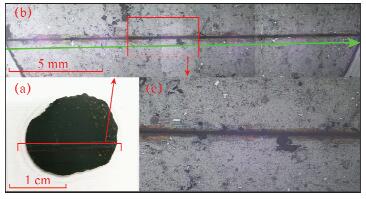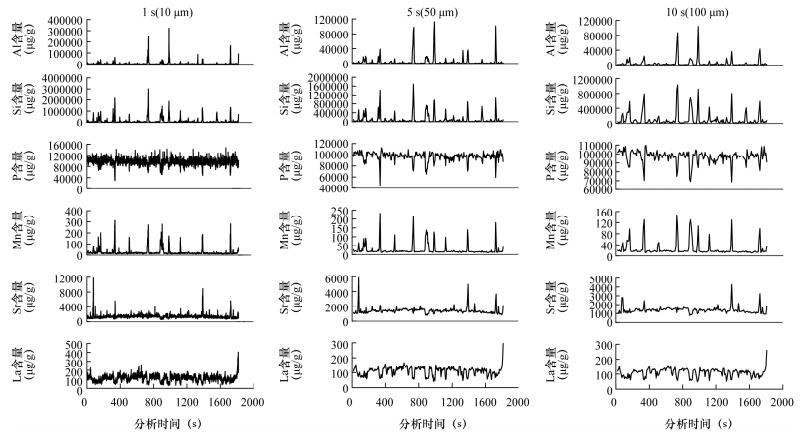Application of Iolite in Data Reduction of Laser Ablation-Inductively Coupled Plasma-Mass Spectrometry Line-scan Analysis
-
摘要: LA-ICP-MS分析技术是获取矿物/岩石内部的元素和同位素成分变化的重要手段。在利用该技术对地质样品进行线/面扫描时,仪器输出的初始数据量远远大于点分析,数据的处理和计算是一个关键问题。本文以磷质结核样品为例,阐述了利用Iolite软件进行元素线扫描数据计算的主要过程,包括背景信号的扣除、标准物质信号的拟合、线分析数据的导出等。借助软件自带的分段导出功能,对不同时间和空间分辨率下采集数据得到的结果进行了比较。研究表明Iolite能有效处理线分析数据,分析结果与前人用传统化学全岩法测定得到的元素含量范围相当。对比不同空间分辨率下(10 μm、50 μm、100 μm)获取的数据发现:相对于选用的束斑直径(40 μm),在分辨率过小(10 μm)或过大(100 μm)的条件下获得的数据存在数据波动大以及细节不足等缺陷;而当分辨率(50 μm)与选用的束斑直径接近时,数据质量得到最大优化。本研究展示了Iolite软件在处理线扫描数据方面具有很好的应用前景,通过分辨率的选取可实现数据的优化。Abstract: Laser Ablation-Inductively Coupled Plasma-Mass Spectrometry (LA-ICP-MS) serves as an important tool for assessing variations in elemental/isotopic compositions of rocks and minerals. During LA-ICP-MS analysis, as spectrometric data acquired via mapping/line analysis are much more than those by single spot analysis, reduction and processing of the obtained data are critical. In this study, Iolite was used to handle LA-ICP-MS data acquired by line analysis on a phosphate nodule. The reduction processes include baseline subtraction, data correction using the interpolation method, and data output. The results obtained using different temporal (spatial) resolution were compared by the section output function of the software. Data reduction of line analysis using Iolite yields results similar to those obtained using wet-chemical analysis. Comparison of different temporal (spatial) resolution (10 μm, 50 μm, 100 μm) for data processing indicates that the results are best optimized when the chosen resolution (50 μm) approximates the spot size (40 μm) during analysis (in Fig.3 and Fig.4). By contrast, results obtained using lower (10 μm) or higher (100 μm) spatial resolution are either fluctuate more or lack detail. These observations indicate that Iolite is a promising tool for LA-ICP-MS data reduction. The results also emphasis the importance of using appropriate temporal (spatial) resolution for data reduction.
-
Keywords:
- LA-ICP-MS /
- Iolite software /
- line analysis /
- phosphate nodule /
- spatial resolution
-
土壤重金属调查与评价的规范很多,例如《土壤地球化学测量规范》(DZ/T 0145—1994)、《多目标区域地球化学勘查规范》(DD2005-01)、《城市环境地质调查评价规范》(DD2008-03)、《土壤环境监测技术规范》(HJ/T 166—2004) 等,但由于行业及研究目的不同而各有侧重。马逸麟等[1]依据《多目标区域地球化学勘查规范》研究了江西省鄱阳湖及周边经济区土壤有机碳储量分布特征,计算出各土壤层的有机碳密度和储量。李玲等[2]对郑州市郊区土壤重金属元素Pb、Cr、Cd、Hg、As污染情况进行了评价分析,各种重金属均有超过背景值现象,其中Cr为重度污染,Pb为轻污染,其他重金属处于警戒线等级。河南省地质调查院在1991~1992年开展的“1:50万郑州—漯河一带土壤地球化学调查”和2004年~2008年完成的“河南省黄淮平原经济区农业地质调查”,结果都显示区内有Hg、Cr、Cd高背景区。
城市土壤重金属调查与评价是建设生态城市的前提和基础之一,理想的调查评价结果应该包括测区土壤中重金属的分布状况、在水平和垂向上的迁移规律、赋存形态及准确的污染评价。本文以郑州市及周边地区为研究区域,采用电感耦合等离子体质谱(ICP-MS)、原子荧光光谱(AFS)等技术对郑州市及周边地区化探扫面(1:10万)采集的1014个表层土壤样品进行分析,结合单因子污染指数法、内梅罗指数法评价土壤中8种重金属(As、Hg、Cd、Cr、Pb、Cu、Zn、Ni)的含量水平、形态特征和污染分布状况,为生态环境综合治理提供了实用价值的基础资料。
1. 样品采集与研究方法
1.1 样品采集
样品采集主要以《土壤地球化学测量规范》为依据,参考《土壤环境监测技术规范》内容,采用网格法采集样品。1:10万土壤化探按1 km×1 km的网度采样,每个样品由相距约300 m的3个子样组成,采样深度为20 cm,采样密度平均为1个/km2,共采集样品1014个。1:5万土壤化探在500 m×250 m的矩形网格的节点上取样,采样深度为20 cm,采样密度平均为8个/km2,共采集样品1006个。T型化探剖面测量的水平点距为20 m,垂直剖面的点距按0~30 cm、30~100 cm、100~150 cm、150~200 cm间隔连续取样,共采集样品120个。形态、价态分析样品共采集样品29个。
1.2 样品加工、分析方法及质量监控
8种重金属全量分析样品的加工流程:将原始样品在自然通风的环境下晾干,捡掉砾石、木屑等,用木棒压碎,过60目筛,然后缩分,取120 g装袋。用氢氟酸-盐酸-高氯酸-硫酸溶解样品,稀逆王水复溶残渣,3%硝酸定容,ICP-MS测定镉、铬、铅、铜、锌、镍。用氢氟酸-硝酸-高氯酸溶解样品,20%盐酸定容,氢化物发生原子荧光光谱法(HG-AFS)测定砷、汞。
重金属形态、价态分析样品的加工流程:将原始样品在自然通风环境下晾干,捡掉砾石、木屑等,用木棒压碎,过20目筛,经室温风干混匀后缩分取土壤试样200 g,采用玛瑙无污染样品制备机具将样品粉碎至100目装袋。取定量样品,分别以水、氯化镁、醋酸钠、焦磷酸钠、盐酸羟胺、过氧化氢为提取剂提取水溶态、离子交换态、碳酸盐结合态、腐植酸结合态、铁锰氧化物结合态、有机结合态,制备各形态分析液。上述提取各形态后的残渣用盐酸、硝酸、高氯酸、氢氟酸处理后制备残留态分析液。用电感耦合等离子体发射光谱法(ICP-OES)分析各相态中的铜、铅、锌、镍、镉、铬,用HG-AFS法分析砷、汞。
分析过程中,按每50个样品为1批,每一个分析批次中各均匀插入4个国家一级或省级标准物质,对分析准确度进行控制,合格率均为100%;按送样总数的5%抽取检查样品,编成密码作为检查样进行分析,控制结果精密度,8个元素的内检合格率全部大于95%;8个元素中除Cd的报出率最低为99.7%之外,其余7个元素的报出率均为100%。
1.3 土壤质量评价方法
土壤重金属污染评价方法[3, 4]有多种,本次采用单因子污染指数法、内梅罗指数法,对郑州市土壤环境质量进行评价。
1.3.1 单因子污染指数法计算方法及分级标准
单因子污染指数法是以土壤元素背景值为评价标准来评价重金属元素的累积污染程度,表达式为:

式中:Pi—土壤中重金属元素i的环境质量指数;Ci—重金属元素i的实测浓度;Si—重金属元素i的土壤环境质量标准(GB15618—1995) 中Ⅱ类土壤(pH值为6.5~7.5) 中重金属元素i的临界值(mg/kg):Cd 0.6,Hg 0.5,As 25,Cu 100,Pb 300,Zn 250,Cr 120,Ni 50。
根据土壤单因子污染指数值,把土壤质量分为5个级别:Ⅰ级(无污染),Pi≤1;Ⅱ级(轻微污染),1<Pi≤2;Ⅲ级(轻度污染),2<Pi≤3;Ⅳ级(中度污染),3<Pi≤5;Ⅴ级(重度污染),Pi>5。
1.3.2 内梅罗指数法计算方法及分级标准
内梅罗指数反映了各污染物对土壤的作用,同时突出了高含量污染物对土壤质量的影响。土壤综合污染指数(P综合)计算公式为:

式中:Pi均—土壤中各污染物的指数平均值;Pi最大—土壤中单项污染物的最大污染指数。
根据内梅罗指数值,把土壤质量分为5个级别:Ⅰ级(清洁),P综合≤0.7;Ⅱ级(尚清洁),0.7<P综合≤1.0;Ⅲ级(轻度污染),1<P综合≤2.0;Ⅳ级(中度污染),2<P综合≤3.0;Ⅴ级(重度污染),P综合>3。
2. 郑州土壤重金属分布特征和污染状况
2.1 重金属区域分布特征
用1:10万土壤化探采集的1014个土壤样品,统计出全区地球化学元素特征值。As、Hg、Cr、Ni、Cu、Zn、Cd、Pb的含量范围(mg/kg)依次为:5.10~20、14~821.30(μg/kg)、28.73~205.67、9.46~28.52、9.01~28.11、29.94~113.23、0.05~1.14、15~206.78,均值(mg/kg)依次为:8.97、56.13(μg/kg)、52.11、52.11、17.64、63.43、0.14、24.51,变异系数依次为:17%、110%、22%、18%、17%、18%、42%、38%,异常样品的个数依次为38、52、49、68、51、53、56、51个。
就均值而言,8种重金属含量都低于《土壤环境质量标准》中Ⅰ类土壤的临界值,说明研究区内土壤质量总体良好,从异常个数看,存在点或面的浓集现象。郑州市土壤中重金属的高背景值主要沿京广铁路两侧展布,并且显示多种重金属叠加。尤其是老城区,数值高,分布面积大。由于工作区地层为第四系的洪积物、冲积物、风积物,所以不可能是成矿作用形成,推断主要为生活和火车废物、废气、废水所致。
在1:10万土壤地球化学测量的基础上,选择5个异常区进行1:5万土壤化探异常查证,地球化学元素特征值见表 1。与1:10万土壤统计的地球化学元素特征值相比,在异常区内重金属含量范围明显变大,变异系数最低的也有1636%,省科委段Hg的变异系数高达63715%。在省科委段,7种重金属(As、Hg、Cd、Cr、Cu、Zn、Ni)最高值为Ⅱ类土壤临界值的1~60倍,尤其是Hg达60多倍,Hg、Cd、Cr、As是污染的主要因子,面积大、强度高,本区位于郑州市城区中心地带,密集分布着行政、商业、居民区等,推断城市人类活动所致。在化工厂段,Cu、Cd最高值分别为Ⅱ类土壤临界值的2.6倍和1.6倍,Hg、Ni、Zn为1~1.5倍,本区为化工厂旧址,推断为原化工厂生产所致。黄岗寺段的Hg、Cr、Cu、Cd、Pb大于Ⅱ类土壤临界值,东赵的Cd、十八里河段的Cd、Hg大于Ⅱ类土壤临界值,这些区段主要分布着农田及居民区,推断为人类生活、农耕所致。
表 1 异常区地球化学元素特征值Table 1. The contents of soil pollutants in anomaly area采样
区段样品
个数项目 As Hg Cr Ni Cu Zn Cd Pb 省科委 577 范围(mg/kg) 4.71~40.31 14.65~32885.79 28.31~197.37 10.46~88.5 10.02~153.55 33.04~449.82 0.016~1.186 15.97~219 均值(mg/kg) 8.75 218.20 56.44 19.87 24.10 89.55 0.18 29.87 标准偏差
(mg/kg)2.22 1390.24 15.09 4.77 11.34 40.88 0.14 17.14 变异系数 25.42 637.15 26.74 24.01 47.06 45.65 73.99 57.38 化工厂 71 范围(mg/kg) 5.77~13.09 15.15~759.6 32.65~94.5 14.63~79.27 11.09~262.7 38.65~387.5 0.06~0.964 15.83~140.7 均值(mg/kg) 9.67 65.16 61.22 22.26 23.54 73.63 0.17 27.83 标准偏差
(mg/kg)1.39 106.69 15.02 7.55 29.58 46.08 0.14 17.11 变异系数 14.40 163.73 24.53 33.90 125.70 62.58 84.61 61.47 东赵 150 范围(mg/kg) 3.49~19.02 14.73~21.83 37.17~2.47 15.2~163.07 13.04~67.42 38.12~240 0.035~0.754 14.63~34.2 均值(mg/kg) 9.62 56.62 59.44 24.13 23.65 76.56 0.14 21.65 标准偏差
(mg/kg)2.55 44.81 16.35 12.25 7.86 30.16 0.09 3.77 变异系数 26.48 79.13 27.50 50.76 33.22 39.39 66.12 17.40 黄岗寺 205 范围(mg/kg) 4.87~12.86 5.32~1233.12 27.2~148.8 10.74~43.54 11.44~133.02 39.1~180.72 0.047~1.798 15.35~364.9 均值(mg/kg) 8.73 72.87 51.54 19.23 19.68 66.34 0.14 28.82 标准偏差
(mg/kg)1.43 114.25 12.39 2.86 9.27 18.60 0.15 38.64 变异系数 16.36 156.80 24.05 14.88 47.11 28.03 103.43 134.09 十八里河 102 范围(mg/kg) 2.72~13.76 15.4~462.22 32.4~91.3 11.6~28.87 10.38~62.46 40.71~180.86 0.026~0.612 15.67~70.31 均值(mg/kg) 7.40 57.69 50.09 17.74 17.58 74.01 0.10 24.67 标准偏差
(mg/kg)1.30 55.45 9.87 3.17 5.60 25.54 0.07 6.94 变异系数 17.61 96.12 19.71 17.88 31.84 34.51 68.37 28.15 注:Hg的数据单位为μg/kg。 2.2 重金属垂向分布特征
一般认为重金属不易随水淋滤,土壤微生物不能分解[5],常被土壤强烈吸附和固定,大多数在土壤表面残留、累积,不易向下层迁移,但是土壤受到重金属污染后,含重金属浓度较高的污染表土可以通过淋滤方式向地下迁移[6]。本研究在典型异常段布设T型剖面,采集深层土壤样品进行分析, 用各层次元素平均值绘制折线图见图 1。可以发现,从地表到深层重金属含量有下降趋势,说明污染源主要来自表层。As在城区内表层土壤中的含量普遍低于深层土壤,郊区则表现为表层高于深层,由此推测As与其他重金属相比更易在水中溶解,在城区随雨水和生活、工业用水的集中排放而下渗到深层土壤。其他重金属一般不易随水淋滤[7]而聚集在土壤表层。
2.3 重金属元素形态特征
重金属在土壤中的环境行为不完全取决于其总量,在一定程度更取决于其化学形态[7]。不同形态重金属,其活性、毒性及生态效应有较大差异[8],一般认为活性态在土壤中易被迁移和被生物吸收。
本次工作在1:5万及土壤剖面工作的基础上,采集了29件样品进行Cu、Zn、Ni、Pb、Cd的形态分析,结果显示各形态分量占全量的比例从大到小依次为:残渣态、铁锰氧化态、腐植酸结合态、碳酸盐结合态、强有机结合态、离子交换态、水溶态,前5种形态占比达95%以上,后2种形态占比不到5%,其中残渣态和铁锰氧化态占比达70%以上。残渣态重金属一般存在于硅酸盐、原生和次生矿物等土壤晶格中, 是自然地质风化过程的结果,铁锰氧化物结合态重金属一般是被铁锰氧化物吸附或共沉淀阴离子而成,在自然界正常条件下,这两种结合态重金属不易释放, 能长期稳定在沉积物中, 难以迁移并不易被植物吸收,说明工作区土壤中重金属的生物活性较差,对环境污染较低。
2.4 土壤重金属污染评价
利用5个异常查证区数据计算单因子污染指数、内梅罗综合污染指数,绘制内梅罗综合指数图(图 2)。省科委段的污染点多、面大,有连片的趋势,个别地段达中度、重度污染,污染元素以Hg、Cd、Zn、As为主。化工厂段为轻度污染,污染元素以Hg、Cd为主。黄岗寺段为轻度污染,污染元素以Cu、Cd、Hg为主。东赵段为轻度污染,污染元素以Ni、Cd为主。十八里河段无污染现象。
3. 土壤环境质量评价
根据《土壤环境质量标准》各类土壤临界值,以1:10万、1:5万土壤地球化学测量数据为基础,绘制郑州市及周边地区土壤质量分级图,用Mapgis软件计算各级土壤面积。结果显示在工作区1000 km2范围内,896 km2都是一级土壤,占比89.6%;94 km2为二级土壤,占比9.4%;10 km2为三级土壤,占比1.0%,表明土壤质量总体良好。
4. 结论
通过对郑州市及周边地区土壤中的重金属调查研究,结果显示工作区内土壤质量总体良好,在极个别中度、重度污染区,重金属集中分布在地表 30 cm之内,且主要以难以迁移和被植物利用的残渣态和铁锰氧化态形式存在,目前对人体及环境的实际危害很小。
本次研究一方面对污染区进行了层层浓缩、立体解剖,定位了污染层的空间分布;另一方面引入了形态分析,确定了污染物的赋存形态,评估了对环境危害的有效程度。该研究成果可为郑州城市发展规划提供详实的地化环境资料,对于后续的进一步研究及修复治理具有较强的实用意义。
-
图 1 (a) 磷质结核剖面照片,红框处为线扫描区域;(b) 磷质结核线扫描区域显微照片,图中中间黑线为线扫描痕迹,绿色箭头指示扫描方向;(c) 为 (b) 中绿色框内区域放大
Figure 1. (a) Picture of the studied phosphate nodule with red square showing the ablated area. (b) Ablated surface of studied phosphate nodule. The dark line in the middle shows the ablated region. The green arrow indicates the direction during the ablation. (c) Magnification of the green square in (b)
表 1 仪器分析参数
Table 1 Working parameters of instrument measurement
电感耦合等离子体质谱 激光剥蚀系统 工作参数 设定值 工作参数 设定值 RF功率 1350 W 能量密度 22 J/cm2 冷却气流量 15.00 L/min 输出比例 90% 辅助气流量 1.00 L/min 束斑大小 40 μm 载气流量 1.02 L/min He气流量 0.85 L/min 数据模式 TRA 检测器模式 双重模式 测试元素 27Al, 29Si, 43Ca, 51V, 55Mn, 57Fe,
88Sr, 89Y, 95Mo, REEs (139La~175Lu),
208Pb, 238U积分时间 Al、Si、P、Fe、Mn、Sr均为1 ms;
其他元素为1.5 ms -
Liu Y S, Hu Z C, Li M, et al.Applications of LA-ICP-MS in the elemental analyses of geological samples[J].Chinese Science Bulletin, 2013, 58:3863-3878. doi: 10.1007/s11434-013-5901-4
李秋立, 杨蔚, 刘宇, 等.离子探针微区分析技术及其在地球科学中的应用进展[J].矿物岩石地球化学通报, 2013:32(3):310-327. http://www.cnki.com.cn/Article/CJFDTOTAL-KYDH201303004.htm Li Q L, Yang W, Liu Y, et al.Ion microprobe microanalytical techniques and their applications in earth sciences[J].Bulletin of Mineralogy, Petrology and Geochemistry, 2013, 32(3):310-327. http://www.cnki.com.cn/Article/CJFDTOTAL-KYDH201303004.htm
李金华, 潘永信.透射电子显微镜在地球科学研究中的应用[J].中国科学 (地球科学), 2015, 45(9):1359-1382. doi: 10.1360/zd2015-45-09-1359 Li J H, Pan Y X.Applications of transmission electron microscopy in the earth sciences[J].Scientia Sinica Terrae, 2015, 45(9):1359-1382. doi: 10.1360/zd2015-45-09-1359
秦玉娟, 张天付, 胡圆圆, 等.电子探针背散射电子图像在碳酸盐岩微区分析中的意义[J].电子显微学报, 2013, 32(6):479-484. http://www.cnki.com.cn/Article/CJFDTOTAL-DZXV201306006.htm Qin Y J, Zhang T F, Hu Y Y, et al.The significance of a back-scattered electron image (of EPMA) in micro-area analyses of carbonate rocks[J].Journal of Chinese Electron Microscopy Society, 2013, 32(6):479-484. http://www.cnki.com.cn/Article/CJFDTOTAL-DZXV201306006.htm
李冰, 周剑雄, 詹秀春.无机多元素现代仪器分析技术[J].地质学报, 2011, 85(11):1878-1916. http://www.cnki.com.cn/Article/CJFDTOTAL-DZXE201111009.htm Li B, Zhou J X, Zhan X C.Modern instrumental analysis of inorganic multi-elements[J].Acta Geologica Sinica, 2011, 85(11):1878-1916. http://www.cnki.com.cn/Article/CJFDTOTAL-DZXE201111009.htm
梁述廷, 刘玉纯, 刘瑱, 等.X射线荧光光谱微区分析在铜矿物类质同象鉴定中的应用[J].岩矿测试, 2015, 34(2):201-206. http://www.ykcs.ac.cn/ykcs/ch/reader/view_abstract.aspx?file_no=20150208&flag=1 Liang S T, Liu Y C, Liu Z, et al.Application of in-situ micro-XRF spectrometry in the identification of copper minerals[J].Rock and Mineral Analysis, 2015, 34(2):201-206. http://www.ykcs.ac.cn/ykcs/ch/reader/view_abstract.aspx?file_no=20150208&flag=1
王坤阳, 徐金沙, 饶华文, 等.扫描电镜-X射线能谱仪在丹巴地区铂族矿物物相特征分析中的应用[J].岩矿测试, 2013, 32(6):924-930. http://www.ykcs.ac.cn/ykcs/ch/reader/view_abstract.aspx?file_no=20130615&flag=1 Wang K Y, Xu J S, Rao H W, et al.Application of SEM and EDS for phase characteristics analysis of platinoid mineral in the Danba area[J].Rock and Mineral Analysis, 2013, 32(6):924-930. http://www.ykcs.ac.cn/ykcs/ch/reader/view_abstract.aspx?file_no=20130615&flag=1
Agangi A, Przybyłowicz W, Hofmann A.Trace element mapping of pyrite from Archean gold deposits-A comparison between PIXE and EPMA[J].Nuclear Instruments & Methods in Physics Research, 2015, 348:302-306.
李献华, 柳小明, 刘勇胜, 等.LA-ICPMS锆石U-Pb定年的准确度:多实验室对比分析[J].中国科学 (地球科学), 2015, 45(9):1294-1303. http://www.cnki.com.cn/Article/CJFDTOTAL-JDXK201509004.htm Li X H, Liu X M, Liu Y S, et al.Accuracy of LA-ICPMS zircon U-Pb age determination:An inter-laboratory comparison[J].Science China (Earth Sciences), 2015, 45(9):1294-1303. http://www.cnki.com.cn/Article/CJFDTOTAL-JDXK201509004.htm
Woodhead J D, Hellstrom J, Hergt J M, et al.Isotopic and elemental imaging of geological materials by laser ablation inductively coupled plasma-mass spectrometry[J].Geostandards and Geoanalytical Research, 2007, 31(4):331-343.
Jackson S E, Pearson N J, Griffin W L, et al.The application of laser ablation-inductively coupled plasma-mass spectrometry to in situ U-Pb zircon geochronology[J].Chemical Geology, 2004, 211(1-2):47-69. doi: 10.1016/j.chemgeo.2004.06.017
Halter W E, Pettke T, Heinrich C A, et al.Major to trace element analysis of melt inclusions by laser-ablation ICP-MS:Methods of quantification[J].Chemical Geology, 2002, 183(1-4):63-86. doi: 10.1016/S0009-2541(01)00372-2
徐伟彪.离子探针测试方法及其在矿物微区微量元素和同位素分析中的应用[J].高校地质学报, 2005, 11(2):239-252. http://www.cnki.com.cn/Article/CJFDTOTAL-GXDX200502011.htm Xu W B.Ion microprobe:Techniques and applications in cosmochemistry and geochemistry[J].Geological Journal of China Universities, 2005, 11(2):239-252. http://www.cnki.com.cn/Article/CJFDTOTAL-GXDX200502011.htm
Riches A J V, Ickert R B, Pearson D G, et al.In situ oxygen-isotope, major-, and trace-element constraints on the metasomatic modification and crustal origin of a diamondiferous eclogite from roberts victor, Kaapvaal craton[J].Geochimica et Cosmochimica Acta, 2016, 174(4):345-359.
Liu Y, Li Q L, Tang G Q, et al.Towards higher precision SIMS U-Pb zircon geochronology via dynamic multi-collector analysis[J].Journal of Analytical Atomic Spectrometry, 2015, 30(4):979-985. doi: 10.1039/C4JA00459K
袁静, 罗立强.同步辐射微区X射线荧光和吸收谱技术在大气、土壤和动植物分析中的应用[J].核技术, 2014, 37(8):1-11. http://www.cnki.com.cn/Article/CJFDTOTAL-HJSU201408001.htm Yuan J, Luo L Q.Synchrotron P-XRF and XAFS in element distribution and speciation of air, soil and biological samples[J].Nuclear Techniques, 2014, 37(8):1-11. http://www.cnki.com.cn/Article/CJFDTOTAL-HJSU201408001.htm
Chang Z, Vervoort J D, Mcclelland W C, et al.U-Pb dating of zircon by LA-ICP-MS[J].Geochemistry, Geophysics, Geosystems, 2006, 7(5):145-162.
Yuan H L, Gao S, Dai M N, et al.Simultaneous determinations of U-Pb age, Hf isotopes and trace element compositions of zircon by excimer laser-ablation quadrupole and multiple-collector ICP-MS[J].Chemical Geology, 2008, 247(1-2):100-118. doi: 10.1016/j.chemgeo.2007.10.003
Frei D, Gerdes A.Precise and accurate in situ U-Pb dating of zircon with high sample throughput by automated LA-SF-ICP-MS[J].Chemical Geology, 2009, 261(3-4):261-270. doi: 10.1016/j.chemgeo.2008.07.025
Solari L A, Gómez-Tuena A, Bernal J P, et al.U-Pb zircon geochronology with an integrated LA-ICP-MS microanalytical workstation:Achievements in precision and accuracy[J].Geostandards & Geoanalytical Research, 2010, 34(34):5-18. https://www.researchgate.net/publication/230412526_U-Pb_Zircon_Geochronology_with_an_Integrated_LA-ICP-MS_Microanalytical_Workstation_Achievements_in_Precision_and_Accuracy
Woodhead J, Hergt J, Meffre S, et al.In situ Pb-isotope analysis of pyrite by laser ablation (multi-collector and quadrupole) ICPMS[J].Chemical Geology, 2009, 262(3-4):344-354. doi: 10.1016/j.chemgeo.2009.02.003
Lee S, Bi X, Reed R B, et al.Nanoparticle size detection limits by single particle ICP-MS for 40 elements[J].Environmental Science & Technology, 2014, 48(17):10291-10300.
George L, Cook N J, Ciobanu C L, et al.Trace and minor elements in galena:A reconnaissance LA-ICP-MS study[J].American Mineralogist, 2015, 100(2-3):548-569. doi: 10.2138/am-2015-4862
Liu P P, Zhou M F, Chen W T, et al.In-situ LA-ICP-MS trace elemental analyses of magnetite:Fe-Ti-(Ⅴ) oxide-bearing mafic-ultramafic layered intrusions of the Emeishan large igneous province, SW China[J].Ore Geology Reviews, 2015, 65(4):853-871. https://www.researchgate.net/publication/272182954_In-situ_LA-ICP-MS_trace_elemental_analyses_of_magnetite_Fe-Ti-V_oxide-bearing_mafic-ultramafic_layered_intrusions_of_the_Emeishan_Large_Igneous_Province_SW_China
Wohlgemuth-Ueberwasser C C, Viljoen F, Petersen S, et al.Distribution and solubility limits of trace elements in hydrothermal black smoker sulfides:An in-situ LA-ICP-MS study[J].Geochimica et Cosmochimica Acta, 2015, 159:16-41. doi: 10.1016/j.gca.2015.03.020
Chen L, Li X H, Li J W, et al.Extreme variation of sulfur isotopic compositions in pyrite from the Qiuling sediment-hosted gold deposit, West Qinling orogen, Central China:An in situ SIMS study with implications for the source of sulfur[J].Mineralium Deposita, 2015, 50(6):643-656. doi: 10.1007/s00126-015-0597-9
Chirinos J R, Oropeza D D, Gonzalez J J, et al.Simultaneous 3-dimensional elemental imaging with Libs and LA-ICP-MS[J].Journal of Analytical Atomic Spectrometry, 2014, 29(7):1292-1298. doi: 10.1039/c4ja00066h
Gao J F, Jackson S E, Dubé B, et al.Genesis of the Canadian Malartic, Côté Gold, and Musselwhite Gold Deposits:Insights from LA-ICP-MS Element Mapping of Pyrite[M].Targeted Geoscience Initiative 4:Contributions to the Understanding of Precambrian Iode Gold Deposits and Implications for Exploration (Dubé B, Mercier-Langevin P), Natural Resources Canada/Ressources naturelles Canada, 2015:157-175.
Becker J S, Matusch A, Bei W.Bioimaging mass spectro-metry of trace elements-Recent advance and applications of LA-ICP-MS:A review[J].Analytica Chimica Acta, 2014, 835(16):1-18.
Liu Y, Hu Z, Gao S, et al.In situ analysis of major and trace elements of anhydrous minerals by LA-ICP-MS without applying an internal standard[J].Chemical Geology, 2008, 257(1-2):34-43. doi: 10.1016/j.chemgeo.2008.08.004
Rittner M, Müller W.2D mapping of LA-ICPMS trace element distributions using R[J].Computers & Geosciences, 2012, 42:152-161.
Paton C, Hellstrom J, Paul B, et al.Iolite:Freeware for the visualisation and processing of mass spectrometric data[J].Journal of Analytical Atomic Spectrometry, 2011, 26(12):2508-2518. doi: 10.1039/c1ja10172b
Paul B, Paton C, Norris A, et al.Cellspace:A module for creating spatially registered laser ablation images within the iolite freeware environment[J].Journal of Analytical Atomic Spectrometry, 2012, 27(4):700-706. doi: 10.1039/c2ja10383d
Zhu B, Jiang S Y, Yang J H, et al.Rare earth element and Sr-Nd isotope geochemistry of phosphate nodules from the lower Cambrian niutitang formation, NW Hunan Province, South China[J]. Palaeogeography, Palaeoclimatology, Palaeoecology, 2014, 398(3):132-143.
Jiang S Y, Zhao H X, Chen Y Q, et al.Trace and rare earth element geochemistry of phosphate nodules from the lower Cambrian black shale sequence in the Mufu Mountain of Nanjing, Jiangsu Province, China[J].Chemical Geology, 2007, 244(3):584-604.
Bian X P, Yang T, Lin A J, et al.Rapid and high-precision measurement of sulfur isotope and sulfur concentration in sediment pore water by multi-collector inductively coupled plasma mass spectrometry[J].Talanta, 2015, 132:8-14. doi: 10.1016/j.talanta.2014.08.053
Mclennan S M.Rare-earth elements in sedimentary rocks:Influence of provenance and sedimentary processes[J].Reviews in Mineralogy, 1989, 21(8):169-200.
赵伦山, 张本仁编著.地球化学[M].北京:地质出版社, 1987:41-43. Zhao L S, Zhang B R.Geochemistry[M].Beijing:Geology Publishing House, 1987:41-43.
Woodhead J D, Hellstrom J, Hergt J M, et al.Isotopic and elemental imaging of geological materials by laser ablation inductively coupled plasma-mass spectrometry[J].Geostandards & Geoanalytical Research, 2007, 31(4):331-343.
Zhu Z, Cook N, Yang T, et al.Mapping of sulfur isotopes and trace elements in sulfides by LA-(MC)-ICP-MS:Potential analytical problems, improvements and implications[J].Minerals, 2016, 6(4):110. doi: 10.3390/min6040110
-
期刊类型引用(5)
1. 林梵宇,尹希杰,刘建鑫,孙延鑫. 原位高分辨微区元素分布特征检测技术的应用进展. 分析测试技术与仪器. 2023(03): 245-260 .  百度学术
百度学术
2. 黄威,胡邦琦,姜学钧,路晶芳,侯方辉,崔汝勇,李攀峰. 九州-帕劳海脊13°20′N海山铁锰结壳生长过程中Si、Al、Ca的含量变化及对碎屑物质供给的指示. 海洋地质与第四纪地质. 2023(05): 26-35 .  百度学术
百度学术
3. 靳梦琪,李艳广,王鹏,汪双双,黎卫亮. 榍石LA-ICP-MS U-Pb定年中元素分馏的影响及校正研究. 岩矿测试. 2020(02): 274-284 .  本站查看
本站查看
4. 胡志中,王坤阳,晏雄,杨波,杜谷. 锆石环氧树脂靶表面形貌特征及对LA-ICP-MS分析影响研究. 岩矿测试. 2020(06): 804-815 .  本站查看
本站查看
5. 周文喜,王华建,付勇,叶云涛,王晓梅,苏劲,王富良,葛枝华,梁厚鹏,魏帅超. 基于LA-ICP-MS多元素成像技术的早寒武世磷结核成因研究. 岩矿测试. 2017(02): 97-106 .  本站查看
本站查看
其他类型引用(3)



 下载:
下载:






 京公网安备 11010202008159号
京公网安备 11010202008159号